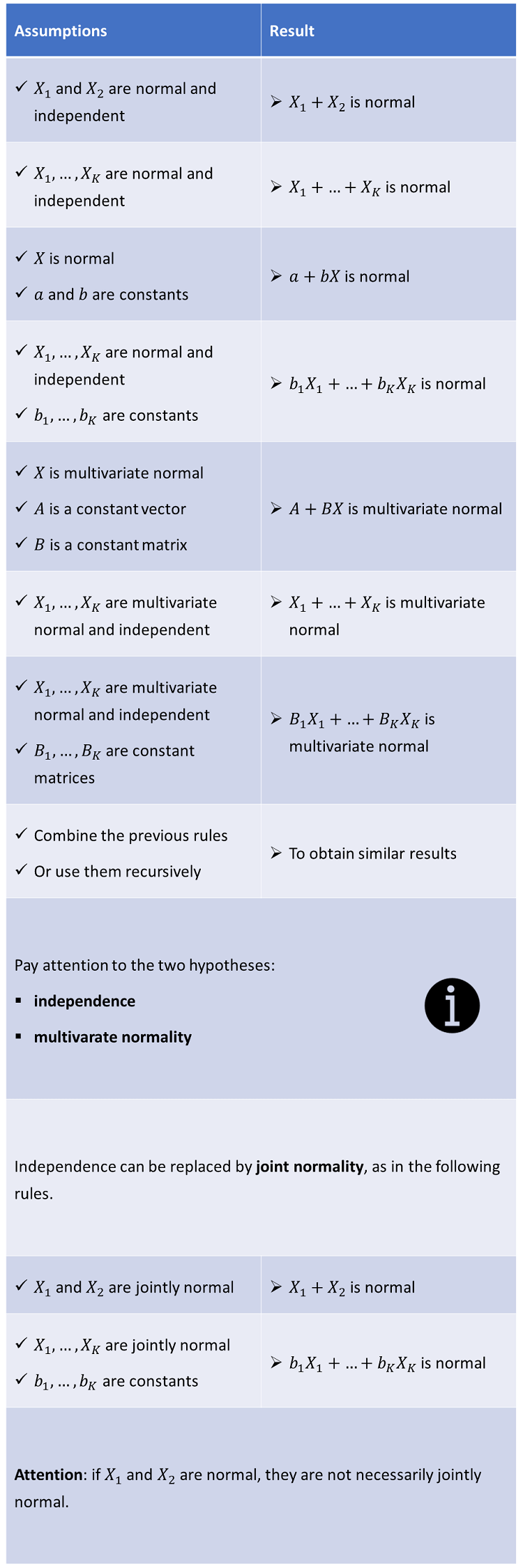A property that makes the normal distribution very tractable from an analytical viewpoint is its closure under linear combinations:
the linear combination of two independent random variables having a normal distribution also has a normal distribution.
The following sections present a generalization of this elementary property and then discuss some special cases, summarized in the following infographic.

Table of contents
Linear transformation of a multivariate normal random vector
A linear transformation of a multivariate normal random vector also has a multivariate normal distribution.
Proposition
Let
be a
multivariate normal random vector with mean
and covariance matrix
.
Let
be an
real vector and
an
full-rank real matrix. Then, the
random vector
defined
by
has
a multivariate normal distribution with
mean
and
covariance
matrix
This is proved using the formula for the
joint moment generating function of the
linear transformation of a random vector. The joint moment generating
function of
is
Therefore,
the joint moment generating function of
is
![[eq5]](/images/normal-distribution-linear-combinations__17.png) which
is the moment generating function of a multivariate normal distribution with
mean
which
is the moment generating function of a multivariate normal distribution with
mean
and covariance matrix
.
Note that
needs to be positive definite in order to be the covariance matrix of a proper
multivariate normal distribution, but this is implied by the assumption that
is full-rank. Therefore,
has a multivariate normal distribution with mean
and covariance matrix
,
because two random vectors have the same distribution when they have the same
joint moment generating function.
The following examples present some important special cases of the above property.
The sum of two independent normal random variables has a normal distribution.
Proposition
Let
be a normal random variable with mean
and variance
.
Let
be a random variable, independent of
,
having a normal distribution with mean
and variance
.
Then, the random
variable
has
a normal distribution with mean
and
variance
First of all, we need to use the fact that
mutually independent normal random variables
are jointly normal: the
random vector
defined
as
has
a multivariate normal distribution with mean
and
covariance matrix
We
can
write
where
Therefore,
according to the above proposition on linear transformations,
has a normal distribution with
mean
and
variance
![]()
The sum of more than two independent normal random variables also has a normal distribution.
Proposition
Let
be
mutually independent normal random variables, having means
and variances
.
Then, the random variable
has
a normal distribution with mean
and
variance
This can be obtained, either generalizing
the proof of the proposition in Example 1, or using the proposition in Example
1 recursively (starting from the first two components of
,
then adding the third one and so on).
The properties illustrated in the previous two examples can be further
generalized to linear combinations of
mutually independent normal random variables.
Example
Let
be
mutually independent normal random variables, having means
and variances
.
Let
be
constants. Then, the random variable
defined
as
has
a normal distribution with mean
and
variance
First of all, we need to use the fact that
mutually independent normal random variables are jointly normal: the
random vector
defined
as
has
a multivariate normal distribution with mean
and
covariance matrix
![[eq31]](/images/normal-distribution-linear-combinations__68.png) We
can
write
We
can
writewhere
Therefore,
according to the above proposition on linear transformations,
has a (multivariate) normal distribution with
mean
and
variance
![[eq35]](/images/normal-distribution-linear-combinations__73.png)
Here is a special case of the above proposition on normal random vectors, for
the case in which
has dimension
(i.e., it is a random variable).
Proposition
Let
be a normal random variable with mean
and variance
.
Let
and
be two constants (with
).
Then the random variable
defined
by
has
a normal distribution with
mean
and
variance
This is just a special case
()
of the above proposition on linear transformations of multivariate normal
vectors.
The property illustrated in Example 3 can be generalized to linear combinations of mutually independent normal random vectors.
Proposition
Let
be
mutually independent
normal random vectors, having means
and covariance matrices
.
Let
be
real
full-rank matrices. Then, the
random vector
defined
as
has
a normal distribution with mean
and
covariance matrix
This is a consequence of the fact that
mutually independent normal random vectors are jointly normal: the
random vector
defined
as
has
a multivariate normal distribution with mean
and
covariance matrix
![[eq48]](/images/normal-distribution-linear-combinations__104.png) Therefore,
we can apply the above proposition on linear transformations to the vector
Therefore,
we can apply the above proposition on linear transformations to the vector
.
Below you can find some exercises with explained solutions.
Let
be
a
multivariate normal random vector with mean
and
covariance
matrix
Find the distribution of the random variable
defined
as
We can
writewhere
Being
a linear transformation of a multivariate normal random vector,
is also multivariate normal. Actually, it is univariate normal, because it is
a scalar. Its mean
is
and
its variance
is
![[eq56]](/images/normal-distribution-linear-combinations__116.png)
Let
,
...,
be
mutually independent standard normal random variables. Let
be a constant.
Find the distribution of the random variable
defined
as
Being a linear combination of mutually
independent normal random variables,
has a normal distribution with
mean
![[eq59]](/images/normal-distribution-linear-combinations__124.png) and
variance
and
variance![[eq60]](/images/normal-distribution-linear-combinations__125.png)
Please cite as:
Taboga, Marco (2021). "Linear combinations of normal random variables", Lectures on probability theory and mathematical statistics. Kindle Direct Publishing. Online appendix. https://www.statlect.com/probability-distributions/normal-distribution-linear-combinations.
Most of the learning materials found on this website are now available in a traditional textbook format.